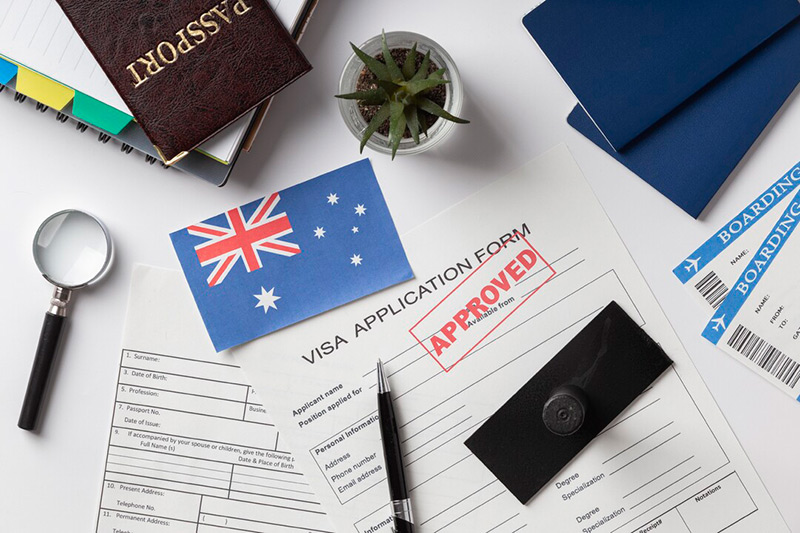
Wishing everyone a Happy New Year!
Australian Prime Minister Albanese delivered a New Year’s message and has unveiled the long-awaited immigration reform strategy for Australia.
From Language Test to age limits : The Key Australian Visa Changes for 2024
This strategy, announced by Minister for Home Affairs Clare O’Neil in early December, primarily focuses on a series of new commitments in the realm of temporary skilled migration and international education. The government plans to implement many of these reform measures in 2024, including stricter English language requirements for student visas and temporary graduate visas, as well as the introduction of new visas for skilled professionals in high-demand fields.
The government has also outlined areas for future reforms, encompassing permanent skilled migration, migration to remote regions, and the Working Holiday Maker program. These discussions are slated to take place during 2024.

1.Providing new visas for workers with in-demand skills.
Perkins indicates that one of the upcoming major changes is the Employer Nomination Scheme visa. The government is introducing a new four-year Temporary Skilled Worker visa, which is designed to provide workers with more opportunities to change employers and offers a pathway to permanent residency.
Upon implementation, the “Critical Skills” visa will replace the current Temporary Skill Shortage visa (subclass 482), which allows holders to reside in Australia while working full-time for a sponsoring employer. According to the government’s new and existing commitments, this is expected to be rolled out by the end of 2024
The visa will have three pathways, with the first being the Expertise Skills pathway, aimed at expediting the visa application process for immigrants with advanced skills. This policy will apply to any occupation with an initial income of at least AUD 135,000, excluding trades workers, machine operators, drivers, and laborers..
2.The government has committed to reducing the average processing time for this visa to 7 days.
The second Core Skills pathway will target most temporary skilled migrants, whose occupations must be listed on a new Core Skills Occupation List, derived from occupations identified as in demand by the Australian Employment and Skills Bureau. Their income must meet the Temporary Skilled Migration Income Threshold (TSMIT), which the government raised from $53,900 to $70,000 earlier in 2023.
3.Annually adjustment on this threshold based on the Wage Price Index.
Unlocking opportunities for skilled workers with modest incomes! Stay tuned for exciting immigration policy adjustments tailored for those with essential skills and lower incomes — the third pathway is set to launch in the first half of 2024.
4.Stringent English Language Proficiency Testing
International Students and Graduates—According to the immigration strategy, constituting the largest segment of Australia’s “perpetual temporary” migrants—stand at the forefront of government reforms.
One of the changes involves an increase in English language requirements.
Starting from the beginning of this year, individuals applying for a student visa will need to achieve a score of 6.0 (up from 5.5) in the International English Language Testing System (IELTS) or equivalent proficiency in other English language tests such as PTE Academic. This adjustment has gained popularity among international students choosing Australia as their educational destination.
The required test scores for temporary graduate visas will also increase from 6.0 to 6.5. The government asserts that this move will enhance the quality of education for students and reduce the potential for workplace exploitation.
5.The new “Genuine Student Test”
Australia’s new immigration strategy will also introduce a new “Genuine Student Test” for all international students, replacing the existing “Genuine Temporary Entrant” requirement. The strategy notes that this will “encourage genuine students to apply and combat non-genuine students whose primary purpose is to work in Australia rather than study.”
This change is expected to be implemented in early 2024.
6.Priority Processing for Student Visas
The government has unveiled new priority processing guidelines for student visa and student guardian visa applications, pledging to rigorously scrutinize applications from “high-risk institutions.” These priority considerations are outlined in the minister’s directive, grounded in the education institution rating system, and are applicable to all applications submitted on or after December 15th.
7.Further Changes to Graduate Work Visas
Starting from the mid of 2024, the government will initiate a “strengthening and streamlining” of the Graduate Work Visa. The changes will encompass:
√ Taxation Imposed on International Students
√ Age Restrictions for Visa Applicants – Under the new arrangement, applicants must be below 35 years old (previously 50 years old).
√ Reduction in Visa Validity Period – initial period of the Graduate Work Visa will now be shortened to two years. Students in remote areas will qualify for a second visa, with validity ranging from one to two years based on their location.
8.New Visa for Immigrants from Pacific Island Nations
his year, a new visa will be introduced for eligible immigrants from Pacific countries and Timor-Leste. The Pacific Engagement Visa will annually allow up to 3000 nationals from participating countries to immigrate to Australia as permanent residents. If selected, applicants will need to meet certain conditions, including having a job in Australia.
9.Priority Processing for Protection Visa Applicants
In October, the government also announced a comprehensive plan of 160 million Australian dollars to help strengthen the refugee visa system after a review found it was being exploited to extend the stay of refugees in Australia.
The strategy outlines the future reform areas slated for discussion in 2024. This encompasses adjusting immigration policies for workers with low incomes yet essential skills and reshaping permanent skilled migration. The government plans to review migration in remote areas and the Working Holiday Maker program to support remote regions and their workforce, with related discussion documents expected to be released early this year.
In conclusion, we wish everyone a prosperous and successful New Year!


